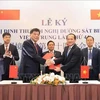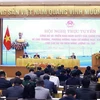Increasing the localisation ratio of leather and footwear products is a priority requirement for the industry in international integration as materials account for 68-75 percent of footwear production costs, the Vietnam Business Forum Magazine (VBF) said.
According to the magazine, the localisation ratio is now only 40-45 percent, while key materials like leather, artificial leather and canvas are mostly imported.
As of early 2014, the country had 129 material producers, including tanners. The industrial production value of the leather and footwear material sector expanded 16.5 percent a year in the 2006-2011 period. The proportion of material value to overall leather and footwear production value was only 20.3 percent in 2011. This growth was lower than the rate recorded by supporting industries of other industries like garment-textile, electronics and mechanics, and was not commensurate with the development potential of supporting industries in Vietnam.
The Vietnam Leather, Footwear and Handbag Association (Lefaso) admitted that the added value of leather, footwear and handbags of Vietnam is still low. In 2013, Vietnam’s leather footwear and handbag export turnover reached 10.3 billion USD, of which materials account for 70 percent, or 7 billion USD. Particularly, imports accounted for 60 percent, or 4.2 billion USD, and domestic sources contributed 40 percent, or 2.8 billion USD.
In addition, Vietnam’s leather and footwear industry is mainly doing outsourcing for foreign companies which assign materials and product designs. A few input materials are just beginning to be manufactured in Vietnam, like leatherette, non-woven fabrics, technical fabrics, soles, accessories, adhesives and chemicals. Vietnam is now supplying below 20 percent of these materials.
Moreover, according to Lefaso, if material output is not invested for expansion after 2013, Vietnam will have to import 75 percent of leather in 2015 and 87 percent in 2025; 96 percent of leatherette in 2015 and 99 percent in 2025; 92 percent of woven and non-woven fabrics in 2015 and 94 percent in 2025.
Currently, Vietnam’s leather, footwear and handbag supporting industries are treated equally with other supporting industries, including incentives for trade promotion, investment credit support, export credit support, export contract execution guarantee. However, to reduce dependency and have input sources, this industry needs more specific support.
In the long run, Vietnam needs to develop and implement consistent mechanisms, policies and measures to attract investment capital from large-scale multinational corporations engaged in leather and footwear production. In addition, financial support, equipment and technology advice are also needed for domestic support enterprises to meet the requirements of FDI firms and increase localisation rates.
In 2014, Vietnam's leather and footwear industry targets to earn 12 billion USD from exports, up 16.5 percent over 2013, including 9.5 billion USD from footwear, up 13 percent, and 2.5 billion USD from handbags, up 31 percent. To achieve this goal, Vietnam should also take advantage of free trade agreements (FTAs) and the Trans-Pacific Partnership (TPP) agreement. These are considered to be a driving force and a golden opportunity for the leather and footwear industry to develop both quantity and quality./.
According to the magazine, the localisation ratio is now only 40-45 percent, while key materials like leather, artificial leather and canvas are mostly imported.
As of early 2014, the country had 129 material producers, including tanners. The industrial production value of the leather and footwear material sector expanded 16.5 percent a year in the 2006-2011 period. The proportion of material value to overall leather and footwear production value was only 20.3 percent in 2011. This growth was lower than the rate recorded by supporting industries of other industries like garment-textile, electronics and mechanics, and was not commensurate with the development potential of supporting industries in Vietnam.
The Vietnam Leather, Footwear and Handbag Association (Lefaso) admitted that the added value of leather, footwear and handbags of Vietnam is still low. In 2013, Vietnam’s leather footwear and handbag export turnover reached 10.3 billion USD, of which materials account for 70 percent, or 7 billion USD. Particularly, imports accounted for 60 percent, or 4.2 billion USD, and domestic sources contributed 40 percent, or 2.8 billion USD.
In addition, Vietnam’s leather and footwear industry is mainly doing outsourcing for foreign companies which assign materials and product designs. A few input materials are just beginning to be manufactured in Vietnam, like leatherette, non-woven fabrics, technical fabrics, soles, accessories, adhesives and chemicals. Vietnam is now supplying below 20 percent of these materials.
Moreover, according to Lefaso, if material output is not invested for expansion after 2013, Vietnam will have to import 75 percent of leather in 2015 and 87 percent in 2025; 96 percent of leatherette in 2015 and 99 percent in 2025; 92 percent of woven and non-woven fabrics in 2015 and 94 percent in 2025.
Currently, Vietnam’s leather, footwear and handbag supporting industries are treated equally with other supporting industries, including incentives for trade promotion, investment credit support, export credit support, export contract execution guarantee. However, to reduce dependency and have input sources, this industry needs more specific support.
In the long run, Vietnam needs to develop and implement consistent mechanisms, policies and measures to attract investment capital from large-scale multinational corporations engaged in leather and footwear production. In addition, financial support, equipment and technology advice are also needed for domestic support enterprises to meet the requirements of FDI firms and increase localisation rates.
In 2014, Vietnam's leather and footwear industry targets to earn 12 billion USD from exports, up 16.5 percent over 2013, including 9.5 billion USD from footwear, up 13 percent, and 2.5 billion USD from handbags, up 31 percent. To achieve this goal, Vietnam should also take advantage of free trade agreements (FTAs) and the Trans-Pacific Partnership (TPP) agreement. These are considered to be a driving force and a golden opportunity for the leather and footwear industry to develop both quantity and quality./.



















